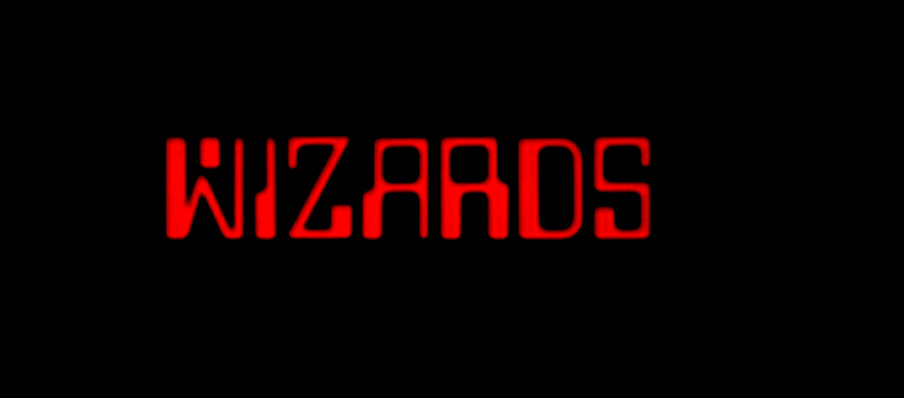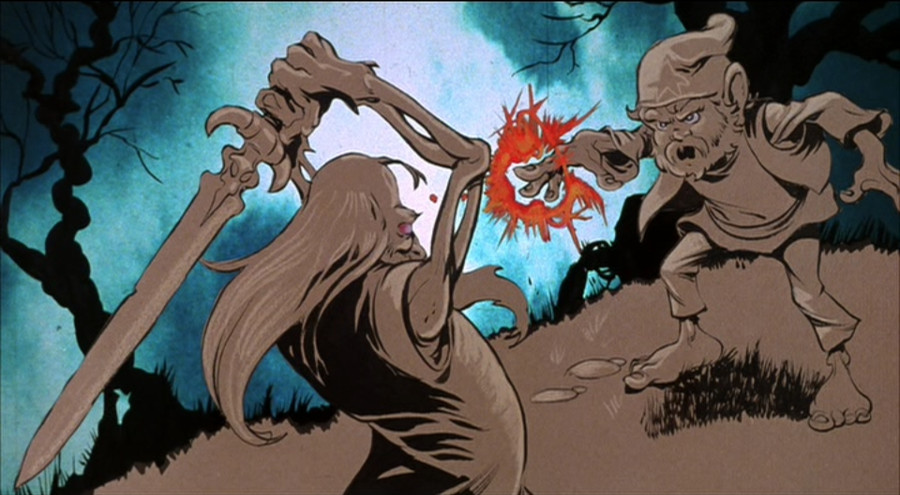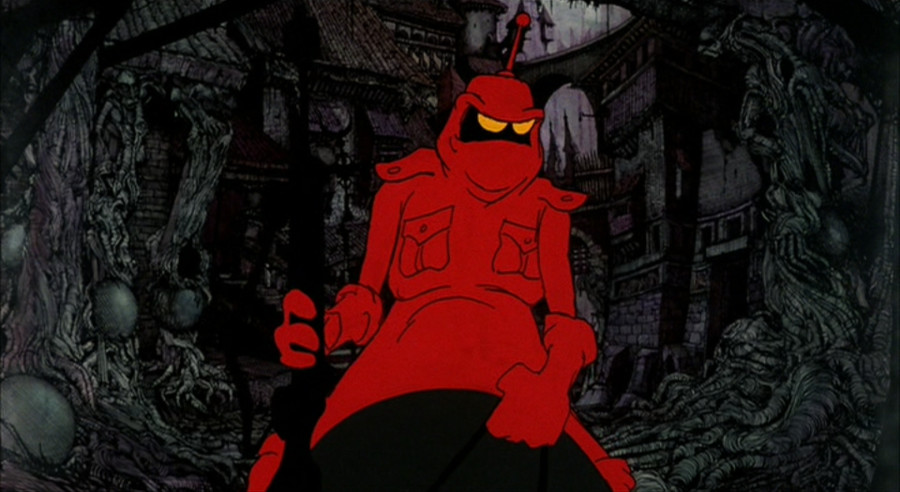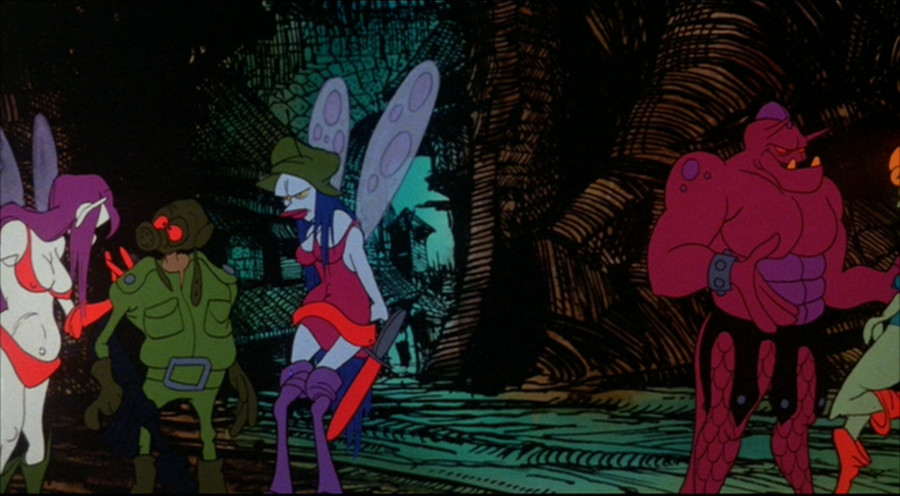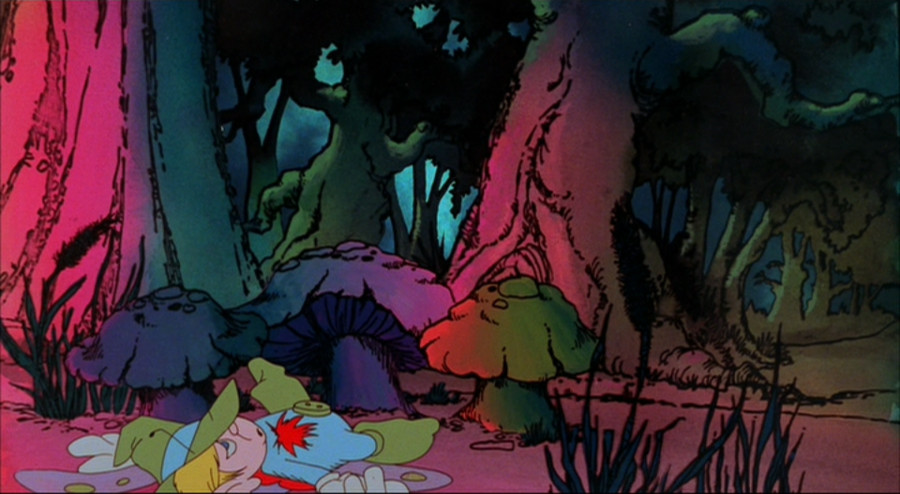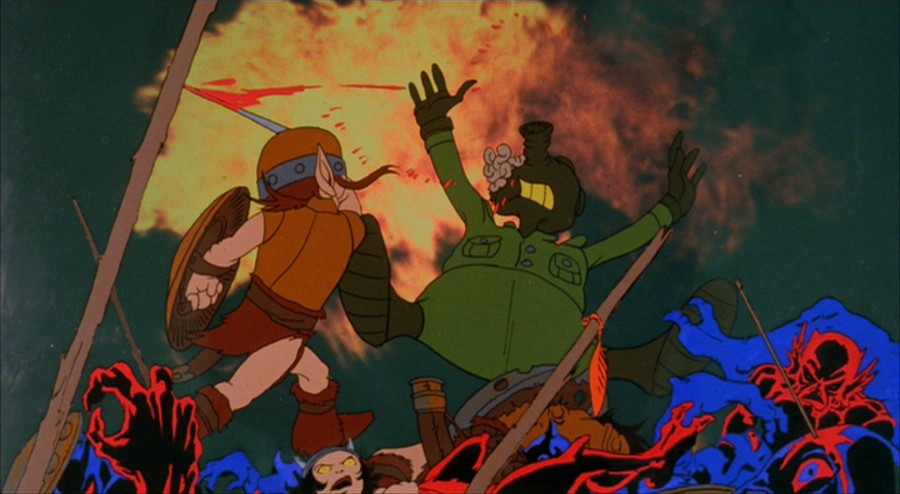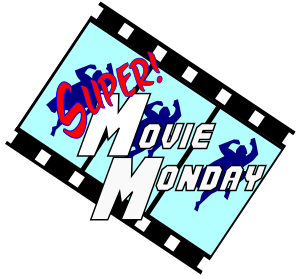
Coming in late today with a non-Spider-man film because The Amazing Spider-Man 2 is being shipped here as you read this. By amazing coincidence, I happened to find a copy of this film for five bucks at Wal-Mart, and I hadn’t seen it for probably 20 years, so I thought I’d check it out. And it’s an amazing example of how much has changed, both technologically and culturally.
Wizards, directed by Ralph Bakshi, is just about the most 70’s film I’ve seen in years, and more uniquely, a film that marries two very different strains of 70’s cinema. On the one hand, it’s a typical 70’s sci-fi/fantasy picture, made toward the end of that particular period in the late 60’s/early 70’s in which SF and fantasy were often blended, the theory being that modern audiences simply could not buy into a story of elves and dragons unless you gave some sort of technical explanation for why they existed (see, for instance, the Dragonriders of Pern series).
On the other hand, it exhibits the influence of that group of so-called New Hollywood filmmakers from the 70’s, people like Martin Scorsese and John Cassavetes and Brian De Palma and Bob Fosse and Sidney Lumet, giving it a bluntly depressing urban sensibility completely at odds with the more mythic subject matter.
The opening titles (seen above) are written in a typical 70’s “futuristic” font over a typical synthesizer-heavy score, after which the story begins in more-or-less Disney fashion with a 4 minute prologue told via storybook-type illustrations.
Except notice that the storybook illustrations look more like comic book drawings (they were done by the brilliant Mike Ploog) with limited animation effects and occasional live-action effects like smoke and lightning composited in the background. And the picture above can’t convey the effect of Susan Tyrell’s narration. She has a very distinctive style, but between the gravel in her voice and her general low-key demeanor, it sounds as if the story is being told by someone who stayed up all night smoking and drinking bourbon in some dive in lower Manhattan.
The story, such as it is, involves two twins born under very mysterious circumstances who grow into rival wizards, the good wizard Avatar and the bad wizard Blackwolf. Magic and fairies and elves have come back to the world in the wake of an atomic holocaust which wiped out civilization. Blackwolf and Avatar fight after their mother’s death, and Blackwolf is driven out into the radioactive wastelands, populated by mutants and monsters, vowing his revenge.
The actual story begins with Blackwolf setting his revenge in motion, sending out three assassins from his fortress in the land of Scortch. The main one we’re interested in is this guy, Nekron 99.
I’m not going to get into the whole issue of how much Bakshi might have plagiarized from Vaughn Bode in the creation of Avatar and Nekron specifically, but Nekron is probably the most striking and visually consistent character in the movie. His nearly single-color design and brooding presence make him stand out. He looks especially good in the shot above, in front of an amazingly detailed background by famed artist Ian Miller (Miller did all the Scortch backgrounds).
That shot above brings up one of the love-it-or-hate-it aspects of Wizards, which is its visual inconsistency (or visual variety, I guess, if you’re in the love-it camp). It’s often hard to tell if Bakshi’s films are so visually inconsistent by design or because of budget problems, but according to commentaries and interviews, Bakshi is said to prefer using a variety of visual approaches for emotional and artistic effect. For instance, all the backgrounds in Scortch are rendered in that very stylized pen-and-ink manner seen above, while in Montagar, the land of the good fairies, the backgrounds are rendered in softer watercolors with black lines over top for definition.
Similarly, characters like Avatar and sexy magic student, the fairy Princess Elinore, are rendered like classic American animation characters ( animated almost exclusively by old-school MGM animator Irven Spence)…
While the massive battle scenes feature lots of very impressionistic rotoscoped figures from old movies done in a very high-contrast style, with some occasional details like glowing red eyes or bat wings added after the fact.
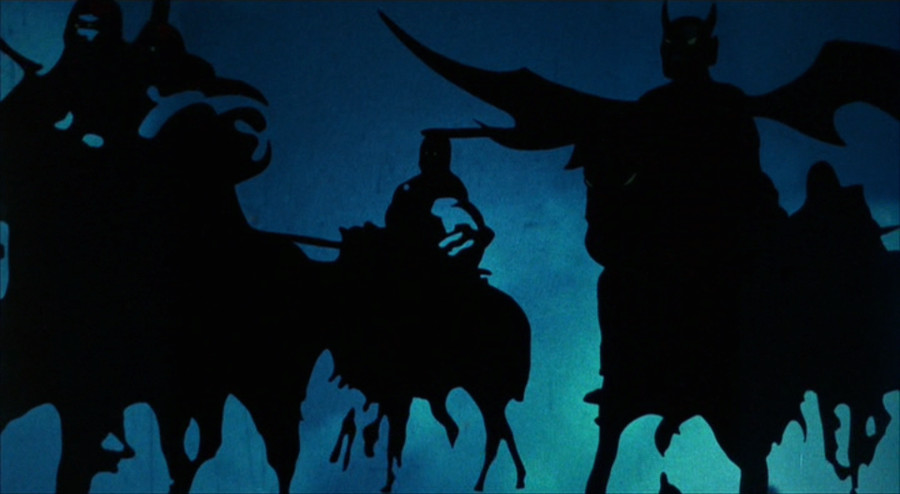 This was done partly to finish the film very cheaply when 20th Century Fox refused to pony up more funds to finish the film (Bakshi tells the story that he and Lucas were turned down for extra funding on the same day). Also partly to prove that Bakshi could produce massive battle scenes on a budget, an important consideration for someone who was planning to adapt The Lord of the Rings as his next project.
This was done partly to finish the film very cheaply when 20th Century Fox refused to pony up more funds to finish the film (Bakshi tells the story that he and Lucas were turned down for extra funding on the same day). Also partly to prove that Bakshi could produce massive battle scenes on a budget, an important consideration for someone who was planning to adapt The Lord of the Rings as his next project.
The problem is that, while I can appreciate the underlying reasoning behind the approach, in practice, the effect is very jarring. Bakshi did not have a large staff, and while he did have some talented people who produced the occasional beautiful shot, the mixture of silly comedy relief Avatar with Ploog-styled comic book elves with Terrytoons-style cloying fairies with underground-comics-style comedy stormtroopers with psychedelic rotoscoped armies over backgrounds that are variously drawn or painted or live-action is very jarring. Not to mention the fact that often, the goals seem to be undercut by cut-rate, inconsistent animation of even the main characters (there are only five animators credited with only three assistants(!) and no time or budget for pencil tests, so clean-up and quality control were almost nonexistent).
And all of this is overlaid with a thick layer of mid-70’s cynical New York ick. Like these fairy prositutes.
I haven’t even gotten into the meat of the story, which is that Blackwolf has uncovered a secret weapon from the ancient world which will motivate his mutant armies to conquer the world. So Avatar, Elinore, elf warrior Weehawk and reformed robot assassin Nekron (now renamed Peace, with the typical subtlety exhibited by Bakshi’s script) set out for Scortch to destroy the weapon. And what is the weapon?
Nazi propaganda films, making this the first of two SF/fantasy films released by 20th Century Fox in 1977 to be inspired in part by Triumph of the Will.
The quest itself is surprisingly brief (not too shocking for a film with an 80-minute run time), but it feels a lot longer than it is. The group ends up in a long side quest featuring cute fairies who turn a lot less cuddly when one of their leaders (voiced by Luke Skywalker himself, Mark Hamill, credited as “Mark Hamil”) is shot.
Notice again the jarring combination of elements: a beautiful background painting with psychedelic colors (is their moon a blacklight?), cute dead fairy in a puddle of blood in the foreground, live-action smoke and lightning effects visible through the trees. Beautiful, but depressing, and not nearly as emotionally affecting as Bakshi clearly intended it to be.
The group escapes the fairies, gets lost in the snow, crosses into a desert where they meet up with this film’s version of Aragorn, ginning up a force to attack the gates of Mordor, er, Scortch, while Avatar’s group plan to continue their mission to destroy the one movie projector to rule them all. Elinore has a face-heel turn which is clearly meant to echo the episode of Pippin and the Palantir in Lord of the Rings, but is so abrupt and out-of-the-blue that any emotional weight it might have held is lost.
Setting us up for the final battle, the simultaneous conflict between armies on the battlefield and wizard brothers in the fortress. The wizard conflict is abrupt and surprising and for me on first viewing, completely unsatisfying. One reviewer I read years ago described it as a kick in the balls, and I completely agree. Years later and much older, I can appreciate the fact that Bakshi was subverting a trope here–I get the joke, and I can even laugh at it sometimes–but it still disappoints on some level. The movie has spent over an hour setting up this titanic battle of wizards, only to spit in your face at the end.
Meanwhile, the final battle is more of what we’ve seen before, only even more graphic.
If one shot can really sum up this movie’s approach, this is it. Live-action explosions in the background, a pile of heavily-stylized demon bodies in impressionistic colors, a Frazetta-style action elf attacking a cartoonish comedy-relief stormtrooper, WHOSE BRAINS ARE SPILLING OUT OF HIS HEAD WOUND.
And understand some context here that I haven’t mentioned before now. Bakshi had spent the last few years making very dark, very adult animated films featuring graphic violence, sex, drug use, profanity, odd digressions into leaden comedy blackouts–equal parts Borscht-Belt corny and ethnically offensive–or “artistic” Greek chorus-style commentary, organized crime, disorganized crime, racist and sexist stereotypes in ham-fisted attempts to subvert and condemn those stereotypes, all in a typically bleak and blighted New York setting. His previous film, Coonskin, had been driven out of theaters by protests from black advocacy groups, and his next project, Hey Good Lookin’, had had its funding pulled by the studio. This was Bakshi’s attempt at rehabilitating his animation career by making a family-friendly film, a movie for kids that would be more “honest” than what Disney was making.
That, up there, is Bakshi’s version of a movie for kids, and he proudly believes he succeeded.
And the weird thing is that, in one sense, he’s right. I saw it on its first release in my mid-teens, and I liked a lot of it. You have to understand, when I say this is a very 70’s movie, this is exactly what I’m talking about. Most movies, especially before Star Wars exploded into theaters later that year and changed the industry forever, depicted a world that was generally depressing and awful. Even the feel-good movies were awful. The urban blight and despair that run through Rocky and Saturday Night Fever. Wacky comedies like The Bad News Bears featuring foul-mouthed latchkey kids playing baseball for an alcoholic coach, and even a screwball homage like What’s Up, Doc? has a nasty grungy undertone in several scenes.
Wizards, as horrifying as it was for the several people I watched it with last week, was actually pretty average on the depressing, grungy scale of the mid-70’s. It is remembered fondly by many fans (most of whom probably haven’t seen it for decades, admittedly). It was Wizards which not only made a decent profit on its miniscule budget, but convinced J.R.R. Tolkien’s daughter to give Bakshi permission to adapt The Lord of the Rings to animation. The two works do have similar themes regarding technology versus love and magic, no matter how tin-eared and clumsy Bakshi is in expressing them.
The other thing you have to understand is that, in those days before the Internet, before the widespread penetration of VHS, before all but the most badly dubbed and butchered-for-kids anime, and most importantly, before it was popularized and made socially acceptable by the unprecedented success of Star Wars, science fiction and fantasy were a ghetto in popular culture. You took what you could get, and most of the time, it was low-budget, badly-written and acted schlock, but it scratched that itch you couldn’t get scratched any other way.
So you had to pan for gold, look for the good moments in mostly bad films. Rollerball is a serious drama that is tremendously boring for much of its running time; Logan’s Run is juvenile schlock for the most part. But both are fondly remembered as classics in the pre-Star Wars era, because they had enough good parts to pick out of the bad. The bad was constant. The bad was a given, always. Hard as it may be to see from a modern perspective, Wizards had enough good parts that it, too, is remembered by many as a classic.
And while it’s not, really, it still has a place in my heart all the same.
I’ll probably revisit some of this in a video next month.

